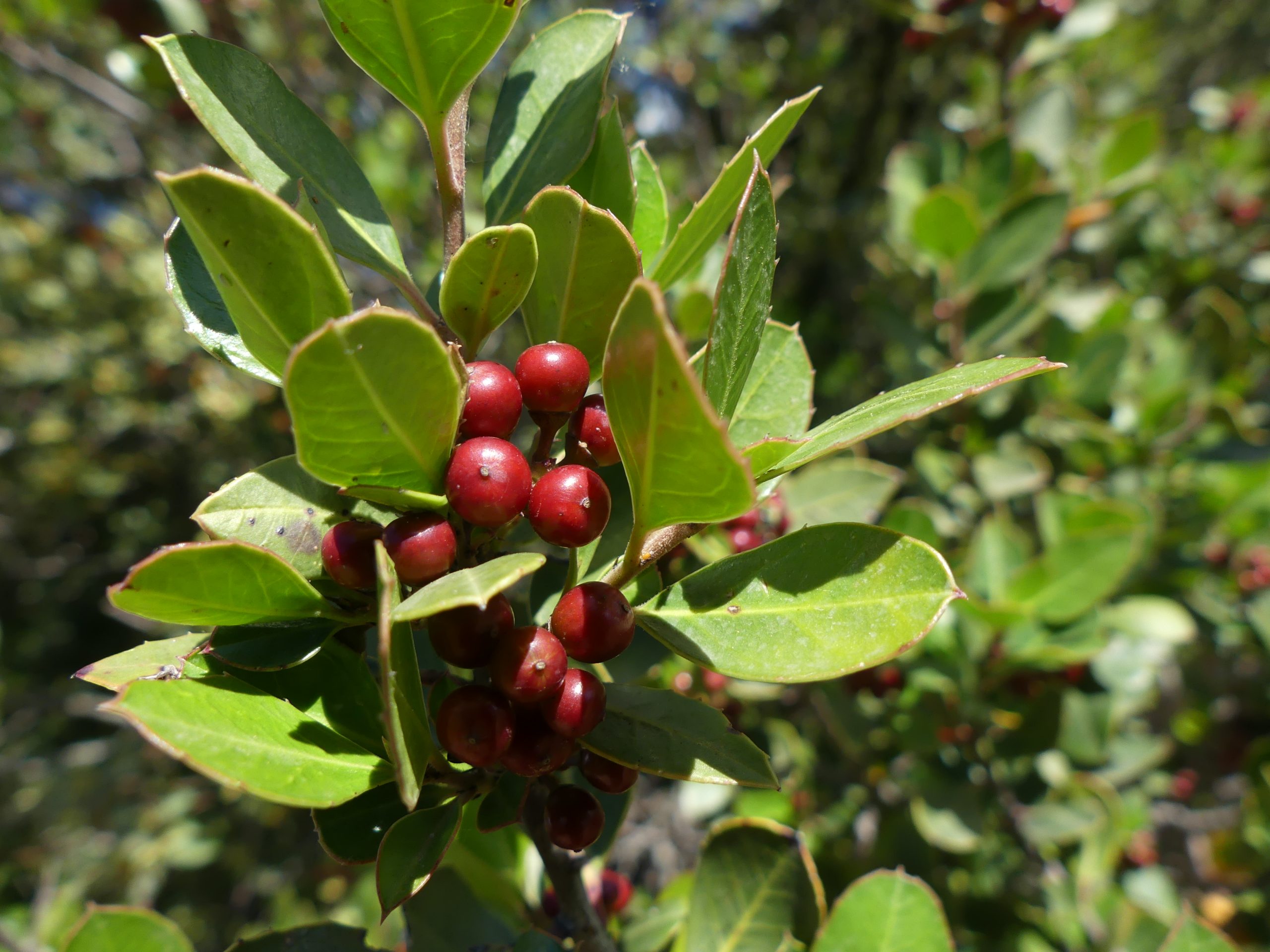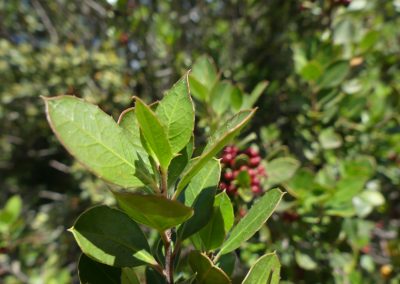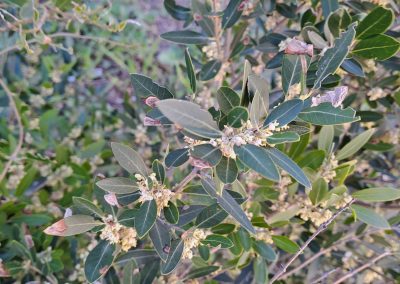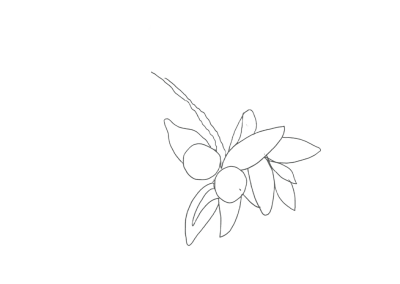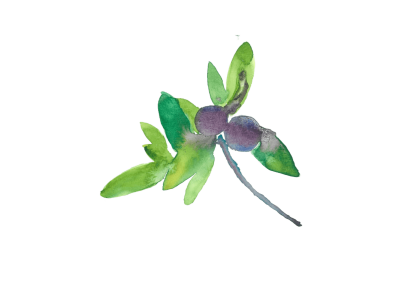Phillyrea media
Scientific description
Taxon: Phillyrea media
Class: Eudicotyledons
Subclass: Asterids
Order: Lamiales
Family: Oleaceae
Common name: Intermediate-leaved Phillyrea
Origin:
Mediterranean region (southern Europe, northern Africa).
Description:
Evergreen shrub up to 4 m tall. Leaves oval to lance-shaped, thick, finely toothed margins, prominent central vein. Small greenish flowers bloom March–May at leaf bases. Fruit is a small black berry (5–7 mm), ripening in autumn.
Propagation:
By seeds or semi-woody cuttings in summer. Seeds germinate slowly but naturally.
Ecology:
Typical of Mediterranean maquis. Thrives on dry, sunny, calcareous soils, hillsides, forest edges, and scrublands.
Uses:
Ornamental shrub in hedges or Mediterranean landscaping. No known edible or medicinal use.
Threats:
Listed as Least Concern. Stable species but locally sensitive to habitat loss and wildfires.
Taxon: Phillyrea media
Classe: Eudicotylédones
Sous-classe: Astéridées
Ordre: Lamiales
Famille: Oléacées (Oleaceae)
Nom commun: Filaire à feuilles intermédiaire
Origine:
Région méditerranéenne (sud de l’Europe, nord de l’Afrique).
Description:
Arbrisseau méditerranéen jusqu’à 4 m, persistant, coriace, vert foncé. Feuilles ovales à lancéolées, bords finement dentés, nervure centrale marquée. Fleurs petites, verdâtres, mars–mai, à l’aisselle des feuilles. Fruits: baies noires de 5–7 mm, visibles à l’automne.
Multiplication:
Par graines ou bouturage semi-ligneux en été. Germination lente mais efficace.
Écologie:
Espèce typique du maquis méditerranéen, sur sols calcaires secs, coteaux, lisières forestières, garrigues exposées au soleil.
Utilisation:
Haies ou massifs pour feuillage persistant. Paysagisme méditerranéen. Pas d’usage alimentaire connu.
Menaces:
Préoccupation mineure. Stable, sensible aux incendies répétés et à l’artificialisation des milieux.
Taxon: Phillyrea media
Clasă: Eudicotiledonate
Subclasă: Asterida
Ordin: Lamiale
Familie: Oleacea
Denumire populară: Filară cu frunze intermediare
Origine:
Regiunea mediteraneană (sudul Europei, nordul Africii).
Descriere:
Arbust veșnic verde, până la 4 m, frunze ovale sau lanceolate, rigide, margine fin dințată, nervură centrală proeminentă. Florile mici, verzi, martie–mai, la baza frunzelor. Fructe: bace negre 5–7 mm, toamna.
Multiplicare:
Prin semințe sau butași semilemnoși vara. Germinarea lentă dar sigură.
Ecologie:
Maquis mediteranean, soluri calcaroase, uscate, însorite, versanți, margini pădure, pajiști aride.
Utilizare:
Plantă ornamentală pentru garduri vii și spații verzi. Fără utilizare alimentară.
Amenințări:
Specie stabilă, risc scăzut. Afectată local de incendii și urbanizare.
Ταξινόμηση: Phillyrea media
Κλάση: Eudicotyledonae
Υποκλάση: Αστερίδες
Τάξη: Lamiales
Οικογένεια: Oleaceae
Κοινή ονομασία: Φιλύρεα η μέση
Προέλευση:
Μεσογειακή περιοχή (νότια Ευρώπη, βόρεια Αφρική).
Περιγραφή:
Αειθαλής θάμνος έως 4 μ., σκούρα πράσινα φύλλα ωοειδή ή λογχοειδή, σαφής κεντρική νεύρωση. Μικρά πράσινα άνθη Μάρτιο–Μάιο στη βάση φύλλων. Καρποί: μικρές μαύρες ράγες 5–7 χιλ., το φθινόπωρο.
Πολλαπλασιασμός:
Με σπόρους ή ημιξυλώδη μοσχεύματα το καλοκαίρι. Αργή αλλά αποτελεσματική βλάστηση.
Οικολογία:
Ζει σε ξηρά, ηλιόλουστα μέρη μακίας, φρυγάνης, ασβεστολιθικά εδάφη, ξέφωτα δασών.
Χρήση:
Καλλωπιστική χρήση σε φράχτες ή τοπιοτεχνία. Δεν έχει διατροφική χρήση.
Απειλές:
Είδος χαμηλής ανησυχίας. Ευαίσθητο σε πυρκαγιές και καταστροφή ενδιαιτημάτων.
Creative writing inspired by Phillyrea media
The filaria
In a magical forest lived an elf whom no one approached or loved. Neither man nor beast. Everyone avoided him because he had strange features and was afraid when they saw him. But the elf was kind and tried to help anyone in need.
In the village next to the forest, a disease broke out, causing a high fever in all the inhabitants. The elf discovered the illness and tried to find a cure to save the village. He made various herbs from the seeds of different plants he found, but none of them helped, and they lost faith in him.
One evening, while out for a walk, he spotted a cave that aroused his curiosity. He goes inside and sees a particular plant, the filaria. He goes to pick some to save the village, but he can't because guards are watching it. However, they are unaware of his presence and he tries to distract them. He throws stones in different places to keep them away.
They leave and he has time to pick up two bags of filaria. He leaves quickly and moves away from the cave. Back home, he prepares some magic herbs from the plant he's picked. He brings it to the village and, although the villagers are initially reluctant to try it, they see they have no choice and drink it. Thanks to filaria, everyone's fever subsides. The plant is said to have medicinal properties, which is why the guards have protected it. All the villagers thank the elf for saving them, and he gives them the last samples of filaria to plant and keep it close to them in case they need to use it.


